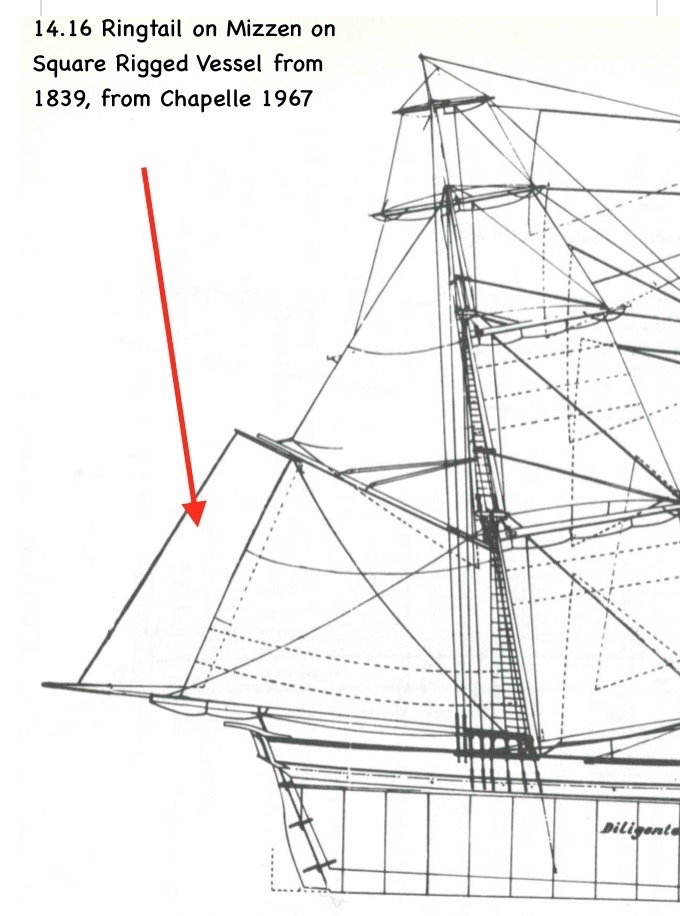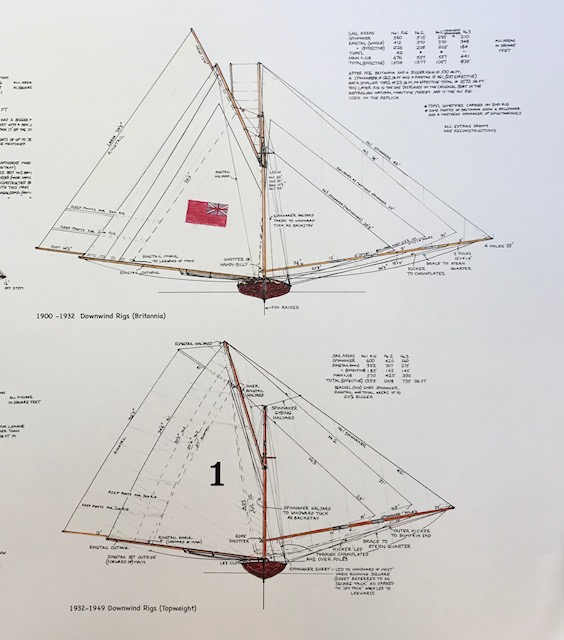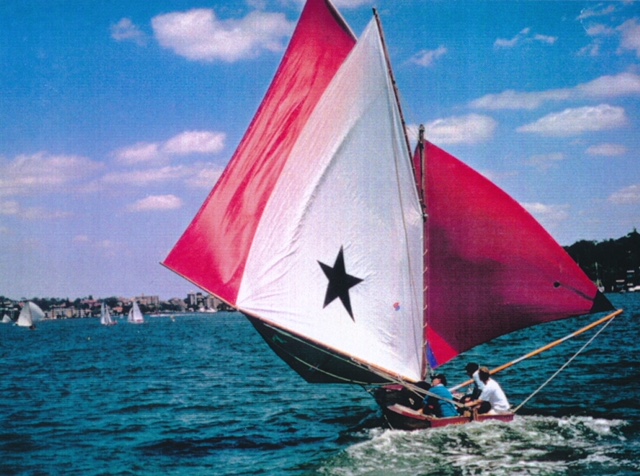Setting extra Sails – Ozzie style
By Ian Smith
If you’re out on Sydney Harbour on any Summer Saturday you’ll see an odd fleet of gaff-rigged, varnished wooden boats racing, and if they’re going downwind you’ll generally see an odd sail slung from the peak of the gaff to the end of the boom overlapping the leech but extending the sail area of the main. They are the replica fleet of historical 18-footers of the Australian Historical Sailing Skiff Association, the the sail is a ringtail, and the history goes back a fair way.
When square-rigged ships found themselves sailing downwind in an area of light breezes and all plain sail was not enough, many had the option of adding studding-sails or stuns’ls, four-sided sails that extended out from each square yard, sometimes on both sides of the boat. On the mizzen gaff, a similar four-sided sail was set between the peak of the gaff and the end of the boom, with its own spars top and bottom. 
Australia’s legendary 18-footers appeared first in the 1890’s but evolved from earlier 22- and 24-footers which go back to the 1870’s, smack in the middle of the Clipper-ship era when ringtails were familiar to all sailors. There are reports of British and Australian yachts setting ringtails in the 1860’s and 70’s, and Sydney’s open boats using them from at least the 1880’s, but I suspect earlier. With most classes of open boats allowing unrestricted sail area, ringtails became popular for downwind runs from an early stage. Squaresails and balloon jibs were the first to go up around a top mark, and the well-hands (those in the middle of the boat, part of a crew of up to 25 in a 24-footer) would start working on setting the ringtail while the squaresail was being set. Spinnakers began to be used in the late 1890’s, at first with a yarded head as they couldn’t believe a 3-sided sail was powerful enough, and soon began to be carried from the peak of the yard tops’l with the halyard taken back to a pin on the tuck (transom). Ringtails were still carried.
Ringtails originally had the top spar close to parallel to the gaff and slung with the halyard in the middle of the spar, so that the spar and sail protruded beyond and above the gaff. The outhaul line on the lower spar which was parallel with the boom was also attached to the middle of the spar, so half of the sail projected beyond the leech of the main, but with the wind far enough aft the air flow fills the whole sail and exhausts through a slot which opens behind the main. The limit of wind angle for carrying a ringtail productively is when the air flow begins to move from forward to aft across the main and also behind it. The forward edge of the ringtail then begins to misbehave.
Around 1930 somebody made a ringtail with a triangular head with the upper spar at the base of the triangle, and these proved easier to set and the high-peaked ringtails began to disappear. The newer-style lasted until the mid 1950’s. Aussie 18’s adopted the the Bermudan rig around 1950 (after several earlier unsuccessful attempts, but that’s a whole other story) but continued to carry ringtails. They became redundant by the mid-’50’s when mainsails developed greater roach (round).
Ringtails can still be seen on some current square-riggers, especially Pride of Baltimore II, and I have seen shots of ringtails on Essex smacks in recent years.
When the Australian Historical Sailing Skiff Association was formed in 1990, there were only a handful of blokes left who had ever set a ringtail. One of the founders, the late Graeme Ferguson made an effort to talk to the older guys about ringtails, and built a rig model to work out how the sails all went together. They set a couple of different ringtails on the first replica of an historical 10-footer built by Robert Tearne, the main instigator of the Association, Janis, and on the second 10-footer Robert and Graeme built, Commonwealth. Several 18-footer replicas were then built, and ringtails began to be set on the third eighteen built in 2000, Aberdare, and most of the next boats with the fleet totalling 11 boats built. Four or five of the fleet regularly set ringtails most races. Most have the later triangular-headed type. My Britannia, a replica of a 1919 boat carries a high-peaked ringtail with first and second rig, and a triangular-headed one for third and fourth rig. Ringtails are regularly set in up to 20 knots of breeze.
The ringtail is hauled up with a halyard in an eye or block at the peak of the gaff, then hauled out to the end of the boom on a usually endless line, and the lower spar is pulled parallel to the boom with an inhaul attached to the inboard end. Most of the replica fleet use a second halyard on the forward end of the upper spar attached at the right spot lower on the gaff. Two elderly legends of the sport disagreed on this, Cliff Monkhouse said they always used the second halyard, Brian Gale said they didn’t, so we can only assume there were differences in the fleet.
At the Sydney Flying Squadron in Careening Cove on Sydney Harbour, the Club that organises the racing, boat crews are awarded a jug of rum and cola each day they set a ringtail. At the post-race presentation, Graeme Ferguson would invariably be asked: “What’s a Ringtail, Fergy?” and Fergy would oblige by announcing: “A ringtail is a sail carried downwind outside the leech of the main to increase the speed of the boat, and the only racing fleet in the world to carry these sails today is the historical 18-footers of the Sydney Flying Squadron!” …followed by loud congratulatory cheers from those present who mostly knew it anyway. All part of the ritual.
Ian Smith sails Britannia with the historical 18-footer fleet at the Sydney Flying Squadron, and is author of The Open Boat- The Origin, Evolution and Construction of the Australian 18-Footer and moderator of the website www.openboat.com.au. A YouTube video “What’s a Ringtail?” has shots of ringtails in action, see below.
Main image: Britannia at Sandy Bay, Hobart 2009, photo credit Terry Dean










